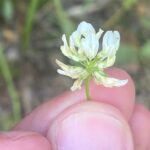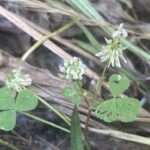Τριφύλλι το μαύρο υποείδος το πετρισάβιο
Etymology of Trifolium nigrescens subsp. petrisavii: The name of the genus, "Trifolium" derives from the Ancient Greek "τρία" [tria], meaning "three" and the Latin "folium", which means "leaf", hence "three-leafed", referring to the three leaflets that comprise a leaf. This word is a calque of the Ancient Greek "τρίφυλλο" [trifyllo], which actually means the same thing. The species name "nigrescens" is derived from the Latin word "niger," meaning "black or dark", and refers to the light brown color that the flowers turn when they are completing their circle of life. The subspecies name "petrisavii" is in honor of the Italian botanist Carlo Petrini (1949- ) and the Croatian botanist Josip Šavikin (1913-1991) to honor their contributions to the field of botany.
Around 36 Trifolium taxa have been identified in the wild Cypriot habitat so far.
Trifolium nigrescens subsp. petrisavii appears later than most trifoliums of Cyprus. It is encountered up to an altitude of 1150 metres in western, central-northern and southeastern Cyprus. Its flowering period is between March and June.
How to identify Trifolium nigrescens subsp. petrisavii:
This subspecies has a small flower head with a diameter of around 1.5 cm; it has white flowers that, when the circle of their life is completed, they turn to a light brown color and wilt downwards, but still remain attached to the inflorescence (key characteristic).
Other characteristics of the subspecies are the following: all its leaves are alternate and its leaflets are obovate to obtriangular, glabrous, bordered by tiny thorns (key characteristic); its inflorescence is distinctly pedunculate, lateral or axillary; its flowers are white or pale pink, and its calyx-tube is 10-nerved, with short calyx-teeth, inconspicuous.








